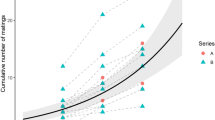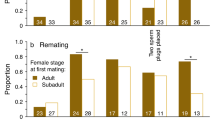Abstract
Variation in reproductive potential usually occurs among individuals of both sexes; for example, some individuals may carry more gametes or be able to continue to generate more gametes in their reproductive life than others. Therefore, to maximize their reproductive success, both sexes are expected to show adaptations for mate choice. However, most authors concentrated on how females choose their mates with the belief that females invest more in reproduction than males, and males are generally eager to pair with any female. In this paper, we report our work on a polygamous moth, Ephestia kuehniella Zeller (Lepidoptera: Pyralidae), with special emphasis on male pre- and in-copulation mate choice in relation to the reproductive quality and re-copulation potential of females. We show that in E. kuehniella, younger and heavier females have significantly higher reproductive value than older and lighter ones, and male sperm supply significantly decreases over successive copulations. Males exercise pre-copulation mate choice by selecting females with higher reproductive potential for copulation and in-copulation mate choice by allocating more sperm to females with higher reproductive potential. However, high-quality females are more likely to re-copulate than low-quality ones, and allocation of more sperm to females by males does not increase female reproductive outputs. It is suggested that the allocation of more sperm to high-quality females functions to increase sperm competitiveness against rivals.








Similar content being viewed by others
References
Arak A (1988) Sexual dimorphism in body size: a model and a test. Evolution 43:820–825
Blanckenhorn WU, Muhlhauser C, Morf C, Reusch T, Reuter M (2000) Female choice, female reluctance to mate and sexual selection on body size in the dung fly Sepsis cynipsea. Ethology 106:577–593
Bonduriansky R (2001) The evolution of male mate choice in insects: a synthesis of ideas and evidence. Biol Rev 76:305–339
Bonduriansky R, Brassil CE (2005) Reproductive ageing and sexual selection on male body size in a wild population of Antler flies (Protopiophila, Litigata). J Evol Biol 18:1332–1340
Calvert I, Corbet SA (1973) Reproductive maturation and pheromone release in the flour moth Anagasta kuehniella (Zeller). J Entomol Ser A Physiol Behav 47:201–209
Cook PA, Gage MJG (1995) Effects of risks of sperm competition on the numbers of eupyrene and apyrene sperm ejaculated by the moth Plodia interpunctella (Lepidoptera, Pyralidae). Behav Ecol Sociobiol 36:261–268
Cook PA, Wedell N (1996) Ejaculate dynamics in butterflies: a strategy for maximizing fertilization success? Proc Roy Soc Lond B Biol 263:1047–1051
Cook PA, Wedell N (1999) Non-fertile sperm delay female remating. Nature 397:486–486
Corbet SA (1973) Oviposition pheromone in larval mandibular glands of Ephestia kuehniella. Nature 243:537–538
Daniel WW (1990) Applied nonparametric statistics. PWS-Kent, Boston
Darwin CR (1859) On the origin of species by means of natural selection, or the preservation of favoured races in the struggle for life. Murray, London
Darwin CR (1871) The descent of man and selection in relation to sex. Murray, London
Dewsbury DA (1982) Ejaculate cost and male choice. Am Nat 119:601–610
Dixson A (2002) Sexual selection by cryptic female choice and the evolution of primate sexuality. Evol Anthropol 11:195–199
Engqvist L, Sauer KP (2003) Determinants of sperm transfer in the scorpionfly Panorpa cognata: male variation, female condition and copulation duration. J Evol Biol 16:1196–1204
Fedina TY (2007) Cryptic female choice during spermatophore transfer in Tribolium castaneum (Coleoptera: Tenebrionidae). J Insect Physiol 53:93–98
Fedina TY, Lewis SM (2007) Female mate choice across mating stages and between sequential mates in flour beetles. J Evol Biol 20:2138–2143
Foster SP (1993) Neural inactivation of sex pheromone production in mated lightbrown apple moths, Epiphyas postvittana (Walker). J Insect Physiol 39:267–273
Friedlander M, Gitay H (1972) The fate of the normal-anucleated spermatozoa in inseminated females of the silkworm Bombyx mori. J Morphol 138:121–130
Gage M (1991) Risk of sperm competition directly affects ejaculate size in the Mediterranean fruit fly. Anim Behav 42:1036–1037
Gage MJG (1998) Influences of sex, size, and symmetry on ejaculate expenditure in a moth. Behav Ecol 9:592–597
Galvani A, Johnstone R (1998) Sperm allocation in an uncertain world. Behav Ecol Sociobiol 44:161–168
Goshima S, Koga T, Murai M (1996) Mate acceptance and guarding by male fiddler crabs Uca tetragonon (Herbst). J Exp Mar Biol Ecol 196:131–143
Jiménez-Pérez A, Wang Q (2004) Effect of body weight on reproductive performance in Cnephasia jactatana (Lepidoptera: Tortricidae). J Insect Behav 17:511–522
Karalius V, Buda V (1995) Mating delay effect on moths’ reproduction: correlation between reproduction success and calling activity in females Ephestia kuehniella, Cydia pomonella, Yponomeuta cognagellus (Lepidoptera: Pyralidae, Tortricidae, Yponomeutidae). Pheromones 5:169–190
Koudelova J, Cook PA (2001) Effect of gamma radiation and sex-linked recessive lethal mutations on sperm transfer in Ephestia kuehniella (Lepidoptera: Pyralidae). Fla Entomol 84:172–182
Lima FM, Favero S, Lima JOGd (2001) Production of the Mediterranean flour moth, Anagasta kuehniella (Zeller) (Lepidoptera: Pyralidae), on an artificial diet containing corn meal. Neotrop Entomol 30:37–42
Linley JR, Hinds MJ (1975) Quantity of male ejaculate influenced by female unreceptivity in fly, Culicoides melleus. J Insect Physiol 21:281–285
Meves F (1903) Ueber oligopyrene und apyrene Spermien und über ihre Entsehung, nach Beobachtungen an Paludina und Pygaera. Archv Mikrosk Anat Entwickl 61:1–82
Norris MJ (1934) Contributions towards the study of insect fertility—III. Adult nutrition, fecundity, and longevity in the genus Ephestia (Lepidoptera, Phycitidae). Proc Zool Soc Lond 1–2:333–360
Olsson M, Madsen T, Shine R (1997) Is sperm really so cheap? Costs of reproduction in male adders, Vipera berus. Proc Roy Soc Lond B Biol 264:455–459
Parker GA (1982) Why are there so many tiny sperm–sperm competition and the maintenance of 2 sexes. J Theor Biol 96:281–294
Parker GA (1990) Sperm competition games—raffles and roles. Proc Roy Soc Lond B Biol 242:120–126
Parker GA, Ball MA, Stockley P, Gage MJG (1996) Sperm competition games: individual assessment of sperm competition intensity by group spawners. Proc Roy Soc Lond B Biol 263:1291–1297
Pitnick S, Markow TA (1994) Male gametic strategies—sperm size, testes size, and the allocation of ejaculate among successive mates by the sperm-limited fly Drosophila pachea and its relatives. Am Nat 143:785–819
Pizzari T, Cornwallis CK, Lovlie H, Jakobsson S, Birkhead TR (2003) Sophisticated sperm allocation in male fowl. Nature 426:70–74
Pureswaran DS, Borden JH (2003) Is bigger better? Size and pheromone production in the mountain pine beetle, Dendroctonus ponderosae Hopkins (Coleoptera: Scolytidae). J Insect Behav 16:765–782
Rahman MM, Roberts HLS, Schmidt O (2004) The development of the endoparasitoid Venturia canescens in Bt-tolerant, immune induced larvae of the flour moth Ephestia kuehniella. J Invertebr Pathol 87:129–131
Rönn JL, Katvala M, Arnqvist G (2008) Interspecific variation in ejaculate allocation and associated effects on female fitness in seed beetles. J Evol Biol 21:461–470
Rutowski RL (1981) Sexual discrimination using visual cues in the checkered white butterfly (Pieris protodice). Z Tierpsychol 55:325–334
SAS I (2006) User’s manual. SAS Institute, Cary
Sato T, Goshima S (2007) Sperm allocation in response to a temporal gradient in female reproductive quality in the stone crab, Hapalogaster dentata. Anim Behav 74:903–910
Savalli UM, Fox CW (1999) The effect of male mating history on paternal investment, fecundity and female remating in the seed beetle Callosobruchus maculatus. Funct Ecol 13:169–177
Simmons LW (2001) Sperm competition and its evolutionary consequences in the insects. Princeton University Press, Princeton
Smith RH (1984) Sperm competition and the evolution of animal mating systems. Academic, London
Thornhill R (1983) Cryptic female choice and its implications in the scorpionfly Harpobittacus nigriceps. Am Nat 122:765–788
Trivers RL (1972) Parental investment and sexual selection. In: Campbell B (ed) Sexual selection and the descent of man 1871–1971. Aldine, Chicago, pp 136–179
Verrell PA (1985) Male mate choice for large, fecund females in the red-spotted newt, Notophthalmus viridescens—how is size assessed. Herpetologica 41:382–386
Wang Q, Yang L, Hedderley D (2008) Function of prolonged copulation in Nysius huttoni White (Heteroptera: Lygaeidae) under male-biased sex ratio and high population density. J Insect Behav 21:89–99
Wedell N, Cook PA (1999) Butterflies tailor their ejaculate in response to sperm competition risk and intensity. Proc Roy Soc Lond B Bio 266:1033–1039
Wedell N, Gage MJG, Parker GA (2002) Sperm competition, male prudence and sperm-limited females. Trends Ecol Evol 17:313–320
Williams GC (1975) Sex and evolution. Princeton University Press, Princeton
Xu J, Wang Q, He XZ (2007) Influence of larval density on biological fitness of Ephestia kuehniela Zeller (Lepidoptera: Pyralidae). N Z Plant Prot 60:199–202
Xu J, Wang Q, He XZ (2008) Emergence and reproductive rhythms of Ephestia kuehniella (Lepidoptera: Pyralidae). N Z Plant Prot 61:277–282
Acknowledgments
We thank K. (C.W.) van Epenhuijsen for his assistance on E. kuehniella colony establishment. We also thank two anonymous reviewers for their constructive comments and suggestions, which have improved the paper. Research reported in this paper was partially supported by a Massey University Doctoral Research Scholarship and by financial assistance in Massey University Institute of Natural Resources.
Author information
Authors and Affiliations
Corresponding author
Additional information
Communicated by L. Simmons
Rights and permissions
About this article
Cite this article
Xu, J., Wang, Q. Male moths undertake both pre- and in-copulation mate choice based on female age and weight. Behav Ecol Sociobiol 63, 801–808 (2009). https://doi.org/10.1007/s00265-009-0713-x
Received:
Revised:
Accepted:
Published:
Issue Date:
DOI: https://doi.org/10.1007/s00265-009-0713-x




